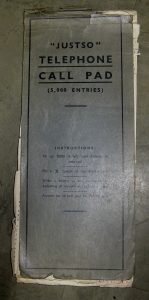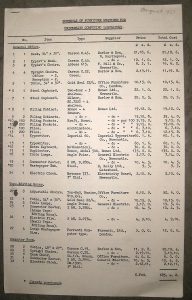Quite apart from everything else going on (IBM 360-67 exhibitions, Sir Robert McAlpine gutting and rebuilding Claremont Tower, Thompsons of Prudhoe removing every last shred of asbestos…) I am continuing to “consolidate the Collection”.
When not swanning off on holiday, or sitting in the garden reading (which as any fule kno, is what every retired person does, most of the time), I visit the Collection twice a week, the goals being (a) to keep an anxious eye on it while the builders are in and (b), the greater goal, to ensure that we know exactly what we have, by checking Roger’s database against the actual artefacts.
Goal B is now almost complete, after two years ( I will be delighted to tell you how it has taken two years). Of the 400+ items in Roger’s database, all but a score or so have now been accounted for. (Meanwhile I’d guess that possibly another 200 have filtered into the Collection since we started this project, and Roger himself had an unknown number of other artefacts; NONE of these are yet catalogued.)
I have at last been able to start going through the heaps of miscellaneous documents (as opposed to objects) which pack out Roger’s old office. I’m pleased to say that I tracked down another six “missing” artefacts today, and photographed many others for the database.
The piles are very miscellaneous: an old catalogue, a pamphlet from a local nature reserve, computer printouts, handbooks, technical papers, hand-written jottings about power-demands, an obituary, hardware specifications, a shopping list … all in the same pile (his office is extremely small: heaps are the natural storage method).
The heap I was going through today contained what I can confidently proclaim is the oldest document in our collection: an architect’s drawing of No.1 Kensington Terrace, dated 1951. This building (recently converted to — guess what! — student accommodation) was where the Computing Laboratory was first located, in the early 50s: possibly this drawing was used as a basis for planning how space was to be used. We have no idea who gave it to Roger, or when, and — like many, many of the documents in his office — it has not been catalogued. There were other interesting documents in that particular part of the pile: I include them here for your amusement — a relief from bits of computing hardware 🙂

“No. 1 Kensington Terrace”. In the small inset you can see how the Great North Road went past Sydenham Terrace (demolished for the Central Motorway).

You moan about the FANGs monitoring your activities? In those far-off days (1958, here), you had to account for every phone call that was made, and pay for if it was personal. ALL of this was typed out; on a piece of paper, by one of the office staff. How busy, and yet how relaxed and unhurried life was then! Now you’ve got your own phone! And look at the life you lead! 😀

… but only 12 years later, the office staff had the use of custom-made logging pads like this: progress. See next.

A typical page from 1971. I see someone (EB) called the Brazilian Embassy; that was Ella Barrett, the much-respected (feared?) Departmental Administrator. Elizabeth Barraclough is always EDB .. and I see that she called Edinburgh Regional Computing Centre (who had use of our IBM 360/67 — a condition of our getting it).
Another thrilling aspect of this artefact (I am not boring you, I am sure) is that on February 17 1971, the UK changed from £sd to decimal, and this book soon changes its notation (and its adding up – try it yourself on this page) to that system.

